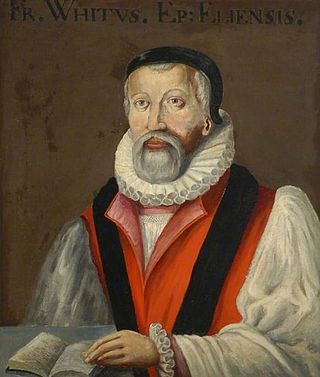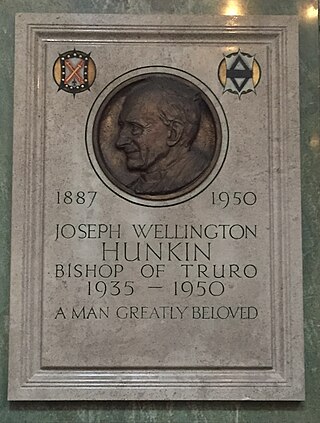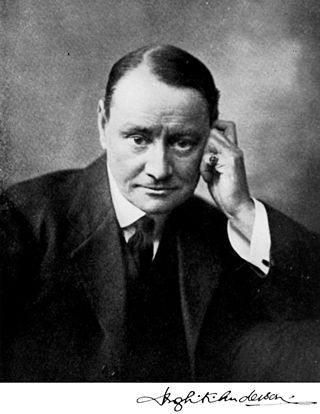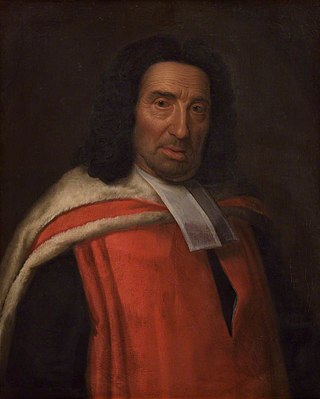
Harvey Goodwin (9 October 1818 – 25 November 1891) was an English academic and Anglican clergyman, Bishop of Carlisle from 1869 until his death.

Harvey Goodwin (9 October 1818 – 25 November 1891) was an English academic and Anglican clergyman, Bishop of Carlisle from 1869 until his death.
Born at King's Lynn, he was a son of Charles Goodwin, a solicitor there; his mother was Frances Sawyer. One of his brothers was Charles Wycliffe Goodwin the Egyptologist and judge. From 1825 to 1833 he was educated at a private school at High Wycombe. Before going into residence at Cambridge, he joined a party at Keswick, Cumberland, and read with William Hepworth Thompson, then a Fellow of Trinity College, Cambridge. He was admitted pensioner of Gonville and Caius College, Cambridge on 16 November 1835, and soon gave evidence of ability in mathematics. From Lady Day 1837 to Michaelmas 1839 he was scholar of his college. In his second year he became a pupil of the private tutor William Hopkins, and in the Mathematical Tripos of 1839 came out second to Robert Leslie Ellis. He was elected second Smith's prizeman, Ellis being first. In 1840 he won the Schuldham prize, and in 1844 delivered the Wortley speech. He graduated Bachelor of Arts (BA) in 1840 and Master of Arts (MA Cantab) in 1843. [1] [2]

On graduating BA, Goodwin was appointed to a mathematical lectureship at Caius, and at Michaelmas 1841 became Fellow of his college. In 1842 he was ordained deacon, and priest in 1844. His close friends at Cambridge, besides Leslie Ellis and Charles Mackenzie, whose life he wrote in 1864, were Thomas Thorp (afterwards Archdeacon of Bristol), John Mason Neale, Philip Freeman, and Benjamin Webb. With them he shared advanced ecclesiological views, and with Neale and Webb he set on foot in 1848 the Ecclesiological Society, which developed into the Cambridge Camden Society. [2]
In 1844 Goodwin took charge, as locum, of St Giles' Church, Cambridge. In the same year he preached for the first time in the university pulpit, and in the year following was nominated select preacher. In 1845 he preached before the British Association, which met at Cambridge. After his marriage, in the same year, he continued to reside at Cambridge, taking pupils and occupying himself with parish work, and he was mainly instrumental in establishing in 1847 the industrial school at Chesterton (later named the Harvey Goodwin Home). In 1848 he was appointed to the incumbency of St Edward's, Cambridge, where he was a popular preacher. [2] [3]
Goodwin was offered the colonial bishopric of Grahamstown in 1853, which he refused. In November 1858 he was appointed Dean of Ely by Edward Smith-Stanley, 14th Earl of Derby. [4] [5] In 1859 received from his university the degree Doctor of Divinity (DD), and the public orator William George Clark spoke of his work. On 11 December 1880 he was elected honorary fellow of Gonville and Caius, and in 1885 was created honorary Doctor of Civil Law (hon. DCL) of Oxford University. As Dean of Ely, Goodwin continued the work of the restoration of Ely Cathedral begun by George Peacock, under Robert Willis's guidance, and he saw completed the painting of the nave roof, which was executed in part by Henry L'Estrange Styleman Le Strange of Hunstanton, and, after his death in 1862, completed by his friend Thomas Gambier Parry. The lantern also was rebuilt, the nave pavement relaid, the Galilee entrance restored, and a warming apparatus placed for the first time in the cathedral. While at Ely he served on two royal commissions, those on clerical subscription and ritual. [2]
In October 1869 he accepted Gladstone's offer to became Bishop of Carlisle. He held the post until his death. [6] From his known interest in scientific subjects he was asked by George Bradley, Dean of Westminster, to preach in Westminster Abbey on the Sunday after the funeral of Charles Darwin, 1 May 1882. He died on 25 November 1891 at Bishopthorpe, while on a visit to William Maclagan, Archbishop of York, and was buried in the churchyard of St Kentigern's Church, Crosthwaite, Keswick. His monument in Carlisle Cathedral consists of a recumbent figure in bronze, executed by Hamo Thornycroft. [7] [2]

Hardwicke Rawnsley wrote a memoir of him. A street in Cambridge and a school in Carlisle are named after Goodwin. [8]
Apart from sermons and lectures, and commentaries on the Gospels of St Matthew (1857), St Mark (1860) and St Luke (1865), his major publications were: [2]
He was also a contributor to the Quarterly Review , Contemporary Review and The Nineteenth Century . [2]
Goodwin married, on 13 August 1845, Ellen, eldest daughter of George King of Bebington Hall, Cheshire, and by her had three sons and four daughters. [2] His son-in-law Henry Ware was Bishop of Barrow-in-Furness from 1891 until 1909. [9] Catherine, the second daughter, married Henry Spooner in 1875.

Sir William Hamo Thornycroft was an English sculptor, responsible for some of London's best-known statues, including the statue of Oliver Cromwell outside the Palace of Westminster. He was a keen student of classical sculpture and was one of the youngest artists to be elected to the Royal Academy, in 1882, the same year the bronze cast of Teucer was purchased for the British nation under the auspices of the Chantrey Bequest.

Francis White was an English bishop and controversialist.

Hardwicke Drummond Rawnsley was an Anglican priest, poet, local politician and conservationist. He became nationally and internationally known as one of the three founders of the National Trust for Places of Historic Interest or Natural Beauty in the 1890s.
Charles Frederick Frazier Mackenzie (1825–62) was a Church of England Bishop of Central Africa. He is commemorated in some Anglican Church Calendars.

Keswick School of Industrial Art (KSIA) was founded in 1884 by Canon Hardwicke Rawnsley and his wife Edith as an evening class in woodwork and repoussé metalwork at the Crosthwaite Parish Rooms, in Keswick, Cumbria. The enterprise, designed to alleviate unemployment, prospered, and within ten years more than a hundred men were attending classes. A new building was erected for the school at a nearby site.
John Keith Oliver is a British retired Anglican bishop. He was the 103rd Bishop of Hereford from 1990 to 2003.

Sir Thomas Gooch, 2nd Baronet (1674–1754) was an English bishop.
Norman Henry Tubbs was an Anglican bishop in the 20th century.

Joseph Wellington Hunkin was the eighth Bishop of Truro from 1935 to 1950.

Frederic Wallis was an Anglican priest.

Gonville and Caius College, often referred to simply as Caius, is a constituent college of the University of Cambridge in Cambridge, England. Founded in 1348 by Edmund Gonville, it is the fourth-oldest of the University of Cambridge's 31 colleges and one of the wealthiest. In 1557, it was refounded by alumnus John Caius. The college has been attended by many students who have gone on to significant accomplishment, including fifteen Nobel Prize winners, the second-highest of any Oxbridge college after Trinity College, Cambridge.

Edmund Keene was an English churchman and academic, who was Master of Peterhouse, Cambridge and later served first as Bishop of Chester, then Bishop of Ely.

Crosthwaite Parish Church is a church at Great Crosthwaite on the outskirts of Keswick in Cumbria, England. It is dedicated to St Kentigern and is the Anglican church of the parish of Crosthwaite. Since 1951 it has been a Grade II* listed building. The church has an evangelical tradition.

Sir Hugh Kerr Anderson was a British physiologist, and educator. He was the son of James Anderson (1811–1897) and Eliza Murray, died 1890 aged 60.
Spencer Cecil Carpenter was an Anglican priest and author. He was the Dean of Exeter in the Church of England from 1935 to 1950.
John Hartstonge or Hartstongue was an English-born prelate of the Church of Ireland who became Bishop of Ossory and then Bishop of Derry.
Thomas Bacon was the fifteenth master of Gonville Hall, Cambridge from 1552.

Sir John Ellys or Ellis (1634?–1716) was an English academic, Master of Gonville and Caius College, Cambridge from 1703.
John Cleugh, D.D. was Archdeacon of Malta from 1865 until his death.
Isaac Newton University Lodge No 859 is a Masonic Lodge based at the University of Cambridge for matriculated members of the university. As of 2013 there were approximately 200 members. This is about half the 397 subscribing members in 1955. The lodge meets at Bateman Street Masonic Hall, with the lodge's badge or standard a combination of Isaac Newton's coat of arms and the University of Cambridge's coat of arms. The lodge is also a member of the Association of Medical, university, and Legal Lodges.
![]() This article incorporates text from a publication now in the public domain: Lee, Sidney, ed. (1901). "Goodwin, Harvey". Dictionary of National Biography (1st supplement). London: Smith, Elder & Co.
This article incorporates text from a publication now in the public domain: Lee, Sidney, ed. (1901). "Goodwin, Harvey". Dictionary of National Biography (1st supplement). London: Smith, Elder & Co.